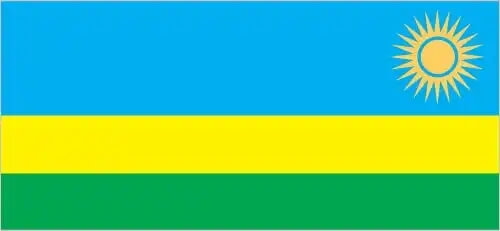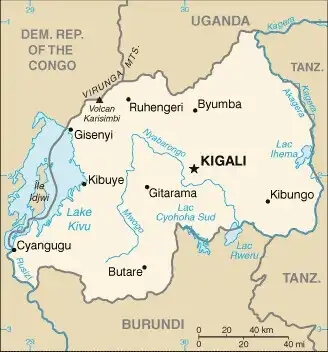World Book
Rwanda
Introduction
Background
A Rwandan kingdom dominated the Great Lakes region from the mid-18th century onward, with Tutsi rulers conquering others militarily and centralizing power. German colonial conquest began in the late 1890s, but the territory was ceded to Belgian forces in 1916 during World War I. Rwandan independence came in 1962. Conflict between Tutsi and Hutu ethnic groups continued for decades, including genocide in 1994. Rwanda held its first local elections in 1999 and its first presidential and legislative elections in 2003.
Geography
Area
total : 26,338 sq km
land: 24,668 sq km
water: 1,670 sq km
Climate
temperate; two rainy seasons (February to April, November to January); mild in mountains with frost and snow possible
Natural resources
gold, cassiterite (tin ore), wolframite (tungsten ore), methane, hydropower, arable land
People and Society
Population
total: 13,623,302 (2024 est.)
Ethnic groups
Hutu, Tutsi, Twa
Languages
Kinyarwanda (official, universal Bantu vernacular) 93.2%, French (official) <0.1%, English (official) <0.1%, Swahili/Kiswahili (official, used in commercial centers) <0.1%, more than one language, other 6.3%, unspecified 0.3% (2002 est.)
Religions
Christian 95.9% (Protestant 57.7% [includes Adventist 12.6%], Roman Catholic 38.2%), Muslim 2.1%, other 1% (includes traditional, Jehovah's Witness), none 1.1% (2019-20 est.)
Population growth rate
1.62% (2024 est.)
Government
Government type
presidential republic
Capital
name: Kigali
Executive branch
chief of state: President Paul KAGAME (since 22 April 2000)
head of government: Prime Minister Justin NSENGIYUMVA (since 23 July 2025)
Diplomatic representation in the US
chief of mission: Ambassador Mathilde MUKANTABANA (since 18 July 2013)
Diplomatic representation from the US
chief of mission: Ambassador Eric KNEEDLER (since 3 October 2023)
Economy
Economic overview
fast-growing Sub-Saharan economy; major public investments; trade and tourism hit hard by COVID-19; increasing poverty after 2 decades of declines; Ugandan competition for regional influence; major coffee exporter; contested GDP figures
Real GDP (purchasing power parity)
$46.543 billion (2024 est.)
$42.743 billion (2023 est.)
$39.485 billion (2022 est.)
Real GDP per capita
$3,300 (2024 est.)
$3,100 (2023 est.)
$2,900 (2022 est.)
Exports
$3.509 billion (2023 est.)
$2.993 billion (2022 est.)
$2.11 billion (2021 est.)
Exports - partners
UAE 66%, China 10%, USA 3%, Kenya 3%, Thailand 2% (2023)
Exports - commodities
gold, rare earth ores, coffee, tea, tin ores (2023)
Imports
$5.783 billion (2023 est.)
$4.978 billion (2022 est.)
$3.856 billion (2021 est.)
Imports - partners
China 19%, Kenya 14%, Uganda 13%, Tanzania 9%, UAE 7% (2023)
Imports - commodities
broadcasting equipment, fish, corn, packaged medicine, plastic products (2023)
Human Development Index
The country's Human Development Index (HDI) is 0.578, ranking it 159th out of 193 countries tested. (more information)



